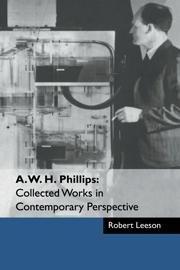Book contents
- Frontmatter
- Contents
- List of contributors
- Foreword by Arthur Brown
- Preface by Robert Leeson
- Part I Bill Phillips: Some Memories and Reflections
- Part II The Phillips Machine
- 8 The origins of the machine in a personal context
- 9 The Phillips Machine as a ‘progressive’ model
- 10 Mechanical models in economic dynamics
- 11 The history of the Phillips Machine
- 12 Early reactions to Mark I and II
- 13 A superb explanatory device
- 14 The Phillips Machine and the history of computing
- Part III Dynamic Stabilisation
- Part IV Econometrics
- References
- Index of names
- Index of subjects
11 - The history of the Phillips Machine
Published online by Cambridge University Press: 04 May 2010
- Frontmatter
- Contents
- List of contributors
- Foreword by Arthur Brown
- Preface by Robert Leeson
- Part I Bill Phillips: Some Memories and Reflections
- Part II The Phillips Machine
- 8 The origins of the machine in a personal context
- 9 The Phillips Machine as a ‘progressive’ model
- 10 Mechanical models in economic dynamics
- 11 The history of the Phillips Machine
- 12 Early reactions to Mark I and II
- 13 A superb explanatory device
- 14 The Phillips Machine and the history of computing
- Part III Dynamic Stabilisation
- Part IV Econometrics
- References
- Index of names
- Index of subjects
Summary
Introduction
When A.W.H. ‘Bill’ Phillips died in Auckland in March 1975 aged sixty he was mourned in a very personal way by many friends, who remem- bered a gentle, shy man with a wry sense of humour, and one who (in their eyes) was always absurdly modest about his major contributions to post-war economics.
He was best known to the world at large for the original exposition of what later became known as the ‘Phillips Curve’ (a name he would never have given it himself). The curve summarised the UK experience of the associated movements of the level of unemployment and the rate of wage inflation over the course of the business cycle. The relationship was seized on as showing the trade-off between unemployment and inflation faced by government policy. It was subsequently argued that the relationship was more complex than Phillips' formulation allowed, in that the trade- off disappeared if the Phillips Curve was extended to include certain types of expectations mechanism. In a sense, therefore, Phillips' work was an indirect progenitor of important later theoretical developments, in particular the systematic analysis of the role of expectations in macroeconomics.
To a smaller group of friends he was remembered also for the ‘Phillips Machine’, a hydraulic model of the UK economy about 7 feet high × 5 feet wide × 3 feet deep, in which the circular flow of income was repre- sented by red water flowing round in clear plastic tubes.
- Type
- Chapter
- Information
- Publisher: Cambridge University PressPrint publication year: 2000
- 10
- Cited by



